The first two pictures on this page are courtesy of Murty Campbell and Stornoway Canoe Club.
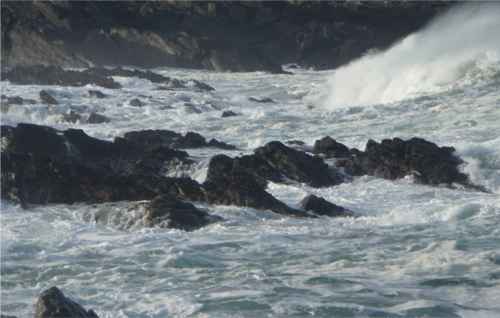 |
Introduction
If you send up flares or trigger an EPIRB, somebody may come to help you but you won't know whether they're coming. If you have a VHF radio or cellular phone you can tell somebody where you are and what help you need, and you know that somebody is coming to help.
Beware the talisman effect. On the highway, people who feel safe because they're wearing a seat-belt or crash helmet are more likely to have an accident. A sea kayaker who has flares or an EPIRB or a VHF radio is more likely to push the limits. Calling for help does not always result in your being rescued promptly, or at all. Kayaking groups should be able to sort out most of their own problems. See Rafting-Up & Towing; Deep-Water Rescue & Self-Rescue; Repairs & Repair Kits; and First Aid Kits.
Let's say that your trip has just gone very wrong, so wrong that you can't get your group to safety. Before you set off you left details of your trip with a friend. Nobody will really worry about you until well after dark, which is probably too late for the Coast Guard to co-ordinate an effective search. In a wilderness area it may be several days before a search begins. Can you speed it up?
VHF radio
A VHF radio is the best way of communicating at sea. It has all sorts of advantages over a cellular phone, particularly if there is an emergency. Here's the relevant page in the USCG Navigation Center.
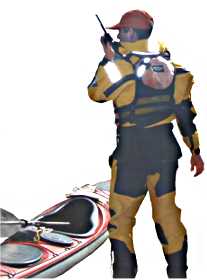 Do you need a radio?
Do you need a radio?
Some sea kayakers would say "never go afloat without one" but that could be excessive. I agree that you need one if you lead groups of inexperienced or young sea kayakers, or if you paddle in an area where you are required to liaise with a port or military authority. They can also be useful for advanced day trips and expeditions.
As a sea kayaker, you can use a VHF radio to:
• Get the permission of port control to enter, cross or leave a major harbor (naval or commercial)
• Pick up maritime weather broadcasts
• Tell the Coast Guard that you have set off from A intending to go to B and will call again on arriving safely
• Tell the Coast Guard you are OK if you hear somebody wrongly report that you are missing or in trouble.
• Receive a message telling you that you are approaching a military exclusion zone or shipping lane
• Send a distress message
• Enable a lifeboat to pinpoint your position by radio direction finding (RDF or just DF)
A VHF radio is a bit of a nuisance. You have to buy it, charge it, carry it, do a radio check to see if still works, listen to it, remember how to talk with it, keep it dry, not drop it, sit on it, lose it or let it re-magnetize your compass, and occasionally carry out battery maintenance.
On the other hand, a good handheld VHF radio is not all that expensive. You want a small waterproof model with at least 4 watts output power and preferably 6 watts. For the USA and Canada it is very useful to have special features for picking up weather radio. A basic VHF radio is quite cheap, but if you live in a country where DSC is legal it’s probably worth paying twice the price to get one that has GPS and DSC. Manufacturers with good reputations include Standard Horizon (Yaesu) and Icom. Both offer handheld radios with 5 watts output power which float if you drop them.
Even with a "waterproof" radio it's good to have some way to keep it dry, such as a small transparent dry bag. It is best to carry a VHF radio someplace you can easily reach it without sinking your kayak, ideally in your PFD pocket so you still have it if you are unlucky enough to lose your kayak. Alternatively in a deck bag, not someplace which will require you to take off a hatch cover or your sprayskirt.
You can get both radio and dry bag from a good kayak store or marine supply store. Probably you can get a cheaper deal on the Internet but make sure you don't get a radio which lacks channels you need, or which is illegal because it gives you one-click access to channels which are reserved for particular Coast Guard, rescue, port, transport or automated weather or distress communications. Different parts of the world use different VHF radio channels. There's a handy list on Wikipedia, and last time we looked the page was http://en.wikipedia.org/wiki/VHF_Marine_Radio. The cheapest deals are usually for radios which have the USA/Canada channels. Your radio MUST NOT be able to transmit voice messages on Channel 70.
When not transmitting, most VHF radio users leave their radios on "dual watch" or “tri watch” so that they hear messages on their usual working channel and also on Channel 16.
Using a VHF radio
Marine VHF radios don’t allow the user to tune them like an ordinary radio. They are preset to give push-button access to a number of “channels”. A good handheld radio will have Channel 16 and at least ten other channels, so you have a choice of working channels and the ability to use the Boater Calling Channel and your favorite local and weather channels.
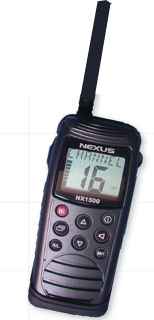 A VHF radio looks like a big cellular phone but it sends a voice message which can be picked up by anybody within range. Some radio signals will travel over the horizon, or right round the world, but we'll be using marine VHF radio for which the maximum range is “line of sight”. If you have a powerful VHF radio and you transmit while standing on top of an island 300 feet high, your message can be heard by anybody 20 or 30 nautical miles away, so this is not a private communications channel.
A VHF radio looks like a big cellular phone but it sends a voice message which can be picked up by anybody within range. Some radio signals will travel over the horizon, or right round the world, but we'll be using marine VHF radio for which the maximum range is “line of sight”. If you have a powerful VHF radio and you transmit while standing on top of an island 300 feet high, your message can be heard by anybody 20 or 30 nautical miles away, so this is not a private communications channel.
The maximum range is limited by the power of your particular radio. A typical yacht radio will transmit with 25 watts in high power mode, but you will get that much power only with a fixed radio that’s permanently mounted, with an external antenna on top of a mast, supplied with electricity from a big external battery. Handheld radios usually have a maximum power of 3 to 6 watts. (For comparison, a cellular phone may transmit at 3 watts.)
If you are sitting in a kayak, your line of sight to the horizon is less than 2 nautical miles. You probably won’t be able to talk to another kayaker further than that, and if there is a big swell running you may be unable to talk to another kayaker a few hundred yards away. That is not the maximum effective range of your VHF radio, because a yacht, ship or coastal radio station will have its antenna mounted on a mast as high as possible above water level. The antenna may be in line of sight even if the ship itself is invisible, hull-down beyond the horizon. See Distance To Horizon.
If you are transmitting from a kayak at sea level, using a 6 watt handheld radio set to "high power" and with a well-charged battery, your message may be picked up by a ship as much as 5 miles away. It may be picked up by a coastal radio station 6 or 7 miles away. 50 miles is occasionally possible in some atmospheric conditions. If you don't get a response to your radio message, kayak to a different location, or land on a beach and climb a hill.
If you have a radio which can transmit with 25 watts, you could stand on top of a 300-foot high island, select “high power” and use the “press to talk” button to wipe out every conversation on that particular channel over more than 100 square miles.
Recreational boaters in the USA may now use a portable VHF marine radio without a license but in many other countries this would be a minor criminal offense. In Canada you need a Restricted Operators’ Certificate (Maritime). In Britain it's a VHF Short Range Certificate. The purpose of the training is so you know:
- not to use "high power" mode unnecessarily
- to keep messages as short as possible
- to transmit as little as possible in a harbor or a busy estuary
- not to transmit foul language, music or chat about football
- not to talk to anybody on shore other than licensed shore stations
- not to use inappropriate channels such as those reserved for port operations, ship movements, search & rescue or Digital Selective Calling
- not to transmit accidentally. If you press the “press to talk” button while trying to find a Snickers bar in your pocket, you can jam the distress channel for miles around.
It’s not “Hey, John, this Brian here again, I mean I want to talk to John Gray on that nice yacht, you know the one I mean, now John I didn't quite hear everything you said, could you repeat the last thing, after you told us where you were? Hello? Oh ..... I mean over” it’s “Bluenose, this is Dyarchy, say again all after your position, over”. You use standard words, and as few of those as possible. Despite this, in busy yachting areas it can be difficult to get a word in edgeways. If there’s a bad storm and a lot of different boats need rescue it may be that most of the VHF channels are closed except for communications about particular rescues.
There's a very nice free online course here: www.egmdss.com/en. OK, it's a European web site, but the system it describes is part of the Global Maritime Distress & Safety System.
When not transmitting, most VHF radio users leave their radios on "dual watch" so that they hear messages on Channel 16 which is the distress, safety & calling channel and also on their regular working channel. In the USA, Channel 9 has been designated the Boater Calling Channel for dual watch and hailing so that Channel 16 can be left for emergency use. The US Coast Guard says "you may use Channel 16 to call a ship or shore station, but if you do so, you must, must be brief! We recommend this same procedure be used over Channel 9, if Channel 9 is used as a calling channel". Dual watch means you hear announcements such as notification that the Coast Guard is about to issue a weather forecast, and any nearby emergency calls or warnings.
Digital Selective Calling
You can now buy a handheld VHF radio with GPS (Global Positioning System) and DSC (Digital Selective Calling). The general idea of DSC is that you can send a burst transmission lasting a fraction of a second which will be received by only one particular radio, or a particular group of radios. It's also possible to send a DSC message to everybody within range. Burst transmission is just our name for it, it's not an official expression. You can’t put much information into your burst, so it’s usually just a “heads up” to say that you’re about to send a voice message. There are four categories of message you can send with a radio - routine, safety, urgency or distress. A routine message could be a DSC burst sent to your friend to say you want to speak to him/her on a particular working channel.
GPS runs your battery down faster but it means that the radio knows its exact position, and Digital Selective Calling enables you to send that position as a MAYDAY transmission by pressing the big red button for 5 seconds. It could save your life. DSC is part of the GMDSS (Global Maritime Distress & Safety System). To come get you, the rescue services need to know what sort of boat they're looking for and where it is. Each marine VHF radio with DSC should be registered with your identity details and given an individual 9-digit number like a telephone number. For example, 366123456. This is the MMSI, which stands for Maritime Mobile Service Identity. In the USA you can get an MMSI number from BOAT US 1-800-563-1536, SEA TOW 1-800-4SEATOW or U.S. Power Squadron. Most of these organizations provide MMSIs at no charge even to non-members. If you sell the radio or the boat you may need to change the details registered for that radio, and change the number programmed into the radio itself.
Each marine VHF radio with DSC should also have a GPS function or be interfaced to a GPS unit, because then it will send not only the identity of your boat but also its exact location. If your radio doesn't have GPS, all it can send will be your MMSI number unless you manually typed in your latitude and longitude. The problem without GPS is that you may have typed it in wrongly, or you may have typed it in some time in the past so it sends the rescue services to where you were last Tuesday.
If you send a distress message using DSC you can also select the nature of the emergency from a short list (sinking, fire/explosion, piracy, etc).
If any DSC radio receives a MAYDAY message it will set off an alarm loud enough to wake the dead.
DSC is a great idea for commercial shipping, but it can be a problem when it's made available to leisure users. Handheld radios with DSC are still illegal in many European countries, or illegal unless the operator has been trained and holds the operator's licence for that country. The USCG said in 2012 "approximately 90% of VHF DSC distress alerts received by the Coast Guard do not contain position information, and approximately 60% do not contain a registered identity".
The DSC system has its own frequency, Channel 70, which is only for short digital burst transmissions. It’s a criminal offence to use it for voice transmissions. That’s not a problem if everybody uses a marine VHF radio because if you try to talk on Channel 70, a marine radio will refuse to transmit anything.
Comms within the group
If your group is taking two or more VHF radios you can agree in advance which of the ship-to-ship (intership) channels you will use as a working channel for communications within the group. In the USA, that will probably be one of Channel 68, 69, 71, 72 or 78. In Canada either Channel 72 or one specified for use in a particular region. In Europe, probably Channel 6, 8, 72 or 77. Again, you will find a list at http://en.wikipedia.org/wiki/VHF_Marine_Radio. .
Radio safety traffic
You may get a frosty answer if you call up the Coastguard to ask for the time of high tide, location of the nearest 7-Eleven or a weather forecast.
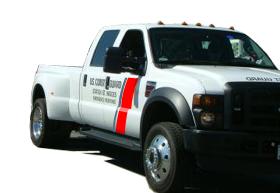 However if you really need weather information and you have a good reason for not having listened to a scheduled broadcast, it would be OK to call the Coastguard because it is "safety traffic". In many countries the Coastguard encourages kayakers to use VHF to notify them that they are going by kayak from point A to point B and again on safe arrival at B.
However if you really need weather information and you have a good reason for not having listened to a scheduled broadcast, it would be OK to call the Coastguard because it is "safety traffic". In many countries the Coastguard encourages kayakers to use VHF to notify them that they are going by kayak from point A to point B and again on safe arrival at B.
Channel 16 is the distress, safety & calling channel and it is essential that it does not get overloaded. Anybody using it must keep their message as short as possible. The first thing the Coastguard will do when responding to a call on Channel 16 is direct you to switch to another channel. In your own home waters you may know that the Coastguard also monitors a channel other than Channel 16, in which case you should use that channel for non-urgent communication. In the USA, you can use Channel 9 as your calling channel.
To send a message, turn on your VHF radio, turn the power setting to "low" if you are within easy sight of the person to whom you want to speak or "high" if they are miles away, turn up the volume, turn down the squelch filter, and select a channel. Listen to make sure it is not in use. Then press the "transmit" or "press to speak" button and say into the microphone something like:
"Portland Coastguard, this is Kayak Group Alpha, Kayak Group Alpha, I have safety traffic, over".
The word "over" means you want a reply. "Out" means that you are ending the discussion. "Over and out" is meaningless. Now take your thumb off the "transmit" button and listen for a response. If you don't get an immediate response you must, except in case of distress, wait at least two minutes before repeating the call.
The Coastguard will respond on Channel 16 telling you to switch immediately to another channel. So the response to your message might be:
"Kayak Group Alpha - Portland Coastguard - Channel 68".
Radio distress calls
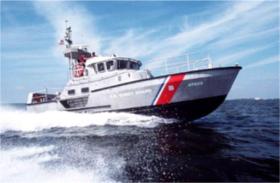 It is a criminal offense in most countries, including the USA, to use a VHF radio to make a MAYDAY call unless you are in "grave and imminent danger" and require immediate assistance.
It is a criminal offense in most countries, including the USA, to use a VHF radio to make a MAYDAY call unless you are in "grave and imminent danger" and require immediate assistance.
If your radio has a DSC function you can send a MAYDAY burst transmission to all ships and radio stations within range, telling them your identity, position, time and the nature of the emergency.
You can also make a voice transmission to say where you are, what the emergency is, and how many people need help. Select the "high power" setting before transmitting. Hold the radio with the antenna vertical. The signal's range and power will be greatly reduced if the antenna is not vertical.
The wording for a distress call is something like:
"MAYDAY MAYDAY MAYDAY.
This is Kayak Group Alpha, Kayak Group Alpha, Kayak Group Alpha, MMSI number 366123456 reporting a medical emergency.
MAYDAY
This is Kayak Group Alpha.
We are two seven zero magnetic from Cape Falcon two miles.
We are a group of seven kayaks, red and yellow in color. We have a kayaker suffering a severe asthma attack. The casualty requires immediate evacuation to hospital by helicopter.
Over."
It would be just as good to say "we are two miles west of Cape Falcon". If you don't get an immediate response to a Mayday call, wait for 10 seconds (US) or one minute (UK) before repeating it.
Battery management
Most handheld VHF radios have Ni-Cad (nickel-cadmium) or NiMH (nickel metal hydride) batteries. According to radio manufacturer Icom, the dreaded "memory effect" has been almost eliminated from new batteries. However improper charging / discharging can still lead to the growth of crystals within the battery which will reduce its performance. You can expect 45% of batteries to fail within 12 months if improperly managed. That figure can be reduced to 15%. On their expert pages Icom advise fully discharging the battery "to less than 0.6V per cell. This is best achieved by using a battery analyzer, designed specifically to cycle the battery correctly". Second best is to leave the radio on until the battery goes flat. NiCd and NiMH batteries "should be cycled periodically to maintain the best performance. This process is sometimes referred to as conditioning. Some manufacturers provide fast chargers that discharge the battery before charging. Although this will prevent crystal degradation, the disadvantage is that the battery life could be reduced. This is because each battery cell has a finite lifetime in cycle terms and conditioning the battery each time uses one of these ‘lives’. To achieve optimum performance NiCd batteries that are in regular use should be conditioned once a month, whilst NiMH batteries need conditioning just once every three months".
Waterproof?
Icom's expert pages advise that a waterproof VHF may be designed to survive spending 30 minutes underwater, to a depth of (say) three feet, but if it does go overboard you should retrieve it as fast as possible and carry out maintenance. "Good practice is to rinse the radio with tap water and dry thoroughly... as salt can cause serious corrosion. After repeated exposure to spray all battery contacts should be inspected, cleaned and lightly greased. Knobs should also be removed and control shafts cleaned and re-greased likewise. After any exposure to moisture the radio should be thoroughly dried."